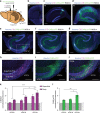A hippocampal circuit linking dorsal CA2 to ventral CA1 critical for social memory dynamics
- PMID: 30301899
- PMCID: PMC6178349
- DOI: 10.1038/s41467-018-06501-w
A hippocampal circuit linking dorsal CA2 to ventral CA1 critical for social memory dynamics
Abstract
Recent results suggest that social memory requires the dorsal hippocampal CA2 region as well as a subset of ventral CA1 neurons. However, it is unclear whether dorsal CA2 and ventral CA1 represent parallel or sequential circuits. Moreover, because evidence implicating CA2 in social memory comes largely from long-term inactivation experiments, the dynamic role of CA2 in social memory remains unclear. Here, we use pharmacogenetics and optogenetics in mice to acutely and reversibly silence dorsal CA2 and its projections to ventral hippocampus. We show that dorsal CA2 activity is critical for encoding, consolidation, and recall phases of social memory. Moreover, dorsal CA2 contributes to social memory by providing strong excitatory input to the same subregion of ventral CA1 that contains the subset of neurons implicated in social memory. Thus, our studies provide new insights into a dorsal CA2 to ventral CA1 circuit whose dynamic activity is necessary for social memory.
Conflict of interest statement
The authors declare no competing interests.
Figures








Similar articles
-
Local circuit allowing hypothalamic control of hippocampal area CA2 activity and consequences for CA1.Elife. 2021 May 18;10:e63352. doi: 10.7554/eLife.63352. Elife. 2021. PMID: 34003113 Free PMC article.
-
The Dendrites of CA2 and CA1 Pyramidal Neurons Differentially Regulate Information Flow in the Cortico-Hippocampal Circuit.J Neurosci. 2017 Mar 22;37(12):3276-3293. doi: 10.1523/JNEUROSCI.2219-16.2017. Epub 2017 Feb 17. J Neurosci. 2017. PMID: 28213444 Free PMC article.
-
The ventral CA2 region of the hippocampus and its differential contributions to social memory and social aggression.Cell Rep. 2025 May 27;44(5):115714. doi: 10.1016/j.celrep.2025.115714. Epub 2025 May 13. Cell Rep. 2025. PMID: 40372914 Free PMC article.
-
Distinct functions of ventral CA1 and dorsal CA2 in social memory.Curr Opin Neurobiol. 2021 Jun;68:29-35. doi: 10.1016/j.conb.2020.12.008. Epub 2021 Jan 6. Curr Opin Neurobiol. 2021. PMID: 33421771 Review.
-
CA2 orchestrates hippocampal network dynamics.Hippocampus. 2023 Mar;33(3):241-251. doi: 10.1002/hipo.23495. Epub 2022 Dec 27. Hippocampus. 2023. PMID: 36575880 Free PMC article. Review.
Cited by
-
Postnatal development of hippocampal CA2 structure and function during the emergence of social recognition of peers.Hippocampus. 2023 Mar;33(3):208-222. doi: 10.1002/hipo.23476. Epub 2022 Oct 30. Hippocampus. 2023. PMID: 36309963 Free PMC article.
-
Altered inhibitory function in hippocampal CA2 contributes in social memory deficits in Alzheimer's mouse model.iScience. 2022 Feb 9;25(3):103895. doi: 10.1016/j.isci.2022.103895. eCollection 2022 Mar 18. iScience. 2022. PMID: 35243253 Free PMC article.
-
Septal cholinergic input to CA2 hippocampal region controls social novelty discrimination via nicotinic receptor-mediated disinhibition.Elife. 2021 Oct 26;10:e65580. doi: 10.7554/eLife.65580. Elife. 2021. PMID: 34696824 Free PMC article.
-
Dynamic and stable hippocampal representations of social identity and reward expectation support associative social memory in male mice.Nat Commun. 2023 May 5;14(1):2597. doi: 10.1038/s41467-023-38338-3. Nat Commun. 2023. PMID: 37147388 Free PMC article.
-
Effects of heterozygous deletion of autism-related gene Cullin-3 in mice.PLoS One. 2023 Jul 10;18(7):e0283299. doi: 10.1371/journal.pone.0283299. eCollection 2023. PLoS One. 2023. PMID: 37428799 Free PMC article.
References
Publication types
MeSH terms
Grants and funding
LinkOut - more resources
Full Text Sources
Medical
Molecular Biology Databases
Research Materials
Miscellaneous

